by Paul Gilster | Sep 6, 2023 | Advanced Rocketry |
Be aware that the Interstellar Research Group has made the videos shot at its Montreal symposium available. I find this a marvelous resource, and hope I never get jaded with the availability of such materials. I can remember hunting desperately for background on talks being given at astronomical conferences I could not attend, and this was just 20 years ago. Now the growing abundance of video makes it possible for those of us who couldn’t be in Montreal to virtually attend the sessions. Nice work by the IRG video team!
There is plentiful material here for the interstellar minded, and I will be drawing on this resource in days ahead. But let’s start with fusion, because it’s a word that all too easily evokes a particular reaction in those of us who have been writing about the field for some time. Fusion has always seemed to be the flower about to bloom, even as decades of research have passed and the target of practical power generation hovers in the future. In terms of propulsion, I’ve long felt that if we had so much trouble igniting fusion on Earth, how much longer would it be before we could translate our knowledge into the tight dimensions of a drive for an interstellar spacecraft?
But if you’ll take a look at Helicity Space’s presentation at the Montreal symposium, you’ll learn about a tightly focused company that approaches fusion from a different direction. Rather than starting with fusion reactors designed to produce power on Earth, Helicity’s entire focus is building a fusion drive for space. NASA’s Alan Stern, of New Horizons fame but also a veteran of decades of space exploration, is senior technical advisor here, and as he puts it, “our goal is not to power up New York City but to push spacecraft.” Stern appeared at Montreal to introduce a panel including Stephane Lintner, the company’s CEO and chief scientist Setthivoine You.

Let’s assume for a moment that at some point in the coming years – we can hope sooner rather than later – we do develop in-space propulsion using fusion. The easiest approach is to contrast working fusion with the methods available to us today. New Horizons was, shortly after launch, the fastest spacecraft ever built; it crossed the orbit of the Moon in a scant 9 hours, but it took a decade to reach Pluto/Charon. We can use gravity assists to sling a payload to the Kuiper Belt, perhaps a craft like JHU/APL’s Interstellar Probe concept, but here we’re dependent on planetary geometry, which isn’t always cooperative, and doesn’t provide the kind of boost that fusion could.
Image: Setthivoine You, co-founder and chief scientist at Helicity Space.
I’m a great advocate of sails, both solar sails and so-called ‘lightsails’ driven by beamed energy, but if reaching a distant target fast is the goal, we’re constrained by the need for a large laser installation and the likelihood, in the near future anyway, of pushing sails that are tiny. New Horizons would take two centuries to reach the Sun’s gravitational lens, a target of JPL’s SGL mission, which will use tight perihelion passes of multiple craft to get up to speed. We continue to talk about decades of travel time, even within the Solar System. As for interstellar, Breakthrough Starshot’s tiny craft, perhaps sent as a swarm to Proxima Centauri, might reach the target in 20 years if all goes well, but data return is a huge problem, and the mission can only be a flyby.
Helicity boldly sketches a future in which we might combine Interstellar Probe and the SGL mission into a single operation using a craft capable of taking a 5 ton payload to the gravitational lens (roughly 600 AU) in a little over a decade. Pluto becomes reachable in some of the Helicity concepts in about a year, with a craft carrying far heavier payloads than New Horizons and abundant power for operations and communications. All this in craft that could be carried into space by existing vehicles like Falcon Heavy or the SLS. The vision reminds us of The Expanse – imagine 4 months to Mars carrying 450 tons of payload as one step along the way.
All of this is a science fictional vision, but the work coming out of Helicity’s labs is solid. It involves so-called peristaltic magnetic compression to compress plasma and raise energy density. The method relies on specific stable behaviors within the plasma, a type of ‘Taylor State’ – these describe plasma within strong magnetic fields – discovered by You. These confine the plasma, while magnetic reconnection heating preheats it in the first place. Setthivoine You describes all this in the video, noting that what Helicity is developing is a method that we can consider magneto-inertial confinement, one producing a plasma jet stabilized through shear flows within the plasma itself. The firm’s computer simulations, in collaboration with Los Alamos National Laboratories, show four jets merging in a double-helix fashion inside the magnetic nozzle. You’s slides, available in the video, are instructive and dramatic.

What emerges from these results is scalable performance, allowing a path forward that the firm hopes to test as early as 2026 in a demonstration flight in orbit, with the possibility of a functional spacecraft at TRL 9 within roughly a decade. The scalable design points to the possibility of compact, reusable spacecraft with the unique feature of continuous thrusting. Think of the Helicity system, Stern has suggested, as a kind of afterburner put onto an electric propulsion system, and one that can scale into a working fusion drive. The concept scales by adding more fusion jets, allowing higher and higher efficiency, until the engine eventually becomes self-sustaining – the energy required to sustain the thrust is less than what the fusion begins to generate.
Does Helicity’s technology have the inside track, or will a contender like the UK’s Pulsar Fusion get to in-space fusion first? The latter is working on a study with Princeton Satellite Systems to examine plasma characteristics in a fusion rocket engine. Helicity’s founders are appropriately cautious about their work and stress how much needs to be learned, but they are continuing to develop the concept in their prototypes. With its laboratory in Pasadena, the company is privately funded and maintains active collaborations with Caltech and Los Alamos as well as UMBC and Swarthmore. Grants from the Department of Energy and other sources have likewise contributed. Have a look at the Montreal video to get a sense of where this exciting research stands, and also a glimpse of the kind of future that in-space fusion propulsion could produce.

by Paul Gilster | Oct 18, 2022 | Advanced Rocketry |
When scientists began seriously looking at beaming concepts for interstellar missions, sails were the primary focus. The obvious advantage was that a large sail need carry no propellant. Here I’m thinking about the early work on laser beaming by Robert Forward, and shortly thereafter George Marx. Forward’s first published work on laser sails came during his tenure at Hughes Aircraft Company, having begun as an internal memo within the firm, and later appearing in Missiles and Rockets. Theodore Maiman was working on lasers at Hughes Research Laboratories back then, and the concept of wedding laser beaming with a sail fired Forward’s imagination.
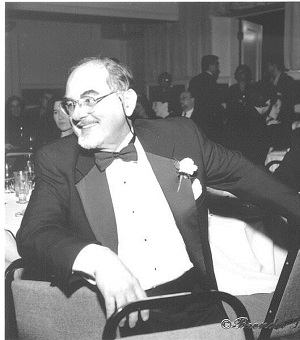
The rest is history, and we’ve looked at many of Forward’s sail concepts over the years on Centauri Dreams. But notice how beaming weaves its way through the scientific literature on interstellar flight, later being applied in situations that wed it with technologies other than sails.
Thus Al Jackson and Daniel Whitmire, who in 1977 considered laser beaming in terms of Robert Bussard’s famous interstellar ramjet concept. A key problem, lighting proton-proton fusion at low speeds during early acceleration, could be solved by beaming energy to the departing craft by laser.
Image: Physicist A. A. Jackson, originator of the laser-powered ramjet concept.
In other words, a laser beam originating in the Solar System powers up reaction mass until the ramjet reaches about 0.14 c. The Bussard craft then switches over to full interstellar mode as it climbs toward relativistic velocities. Jackson and Whitmire would go on in the following year to confront the problem that a ramscoop produced enough drag to nullify the concept. A second design emerged, using a space-based laser to power up a starship that used no ramscoop but carried its own reaction mass onboard.
The beauty of the laser-powered rocket is that it can accelerate into the laser beam as well as away from it, since the beam provides energy but is not used to impart momentum, as in Forward’s thinking about sails. In the paper, huge lasers are involved, up to 10 kilometers in diameter, with a diffraction limited range of 500 AU.
But note this: As far back as 1967, John Bloomer had proposed using an external energy source on a departing spacecraft, but focusing the beam not on a departing fusion rocket but one carrying an electrical propulsion system bound for Alpha Centauri. So we have been considering electric propulsion wed with lasers as far back as the Apollo era.
Now we can swing our focus back around to the paper by Angelo Genovese and Nadim Maraqten that was presented at the recent IAC meeting in Paris. Here we are looking not at full-scale missions to another star, but the necessary precursors that we’ll want to fly in the relatively near-term to explore the interstellar medium just outside the Solar System. The problem is getting there in a reasonable amount of time.
As we saw in the last post, electric propulsion has a rich history, but taking it into deep space involves concepts that are, in comparison with laser sail proposals, largely unexplored. A brief moment of appreciation, though, for the ever prescient Konstantin Tsiolkovsky, who sometimes seems to have pondered almost every notion we discuss here a century ago. Genovese and Maraqten found this quote from 1922:
“We may have a case when, in addition to the energy of ejected material, we also have an influx of energy from the outside. This influx may be supplied from Earth during motion of the craft in the form of radiant energy of some wavelength.”
Tsiolkovsky wouldn’t have known about lasers, of course, but the gist of the case is here. Angelo Genovese took the laser-powered electric propulsion concept to Chattanooga in 2016 when the Interstellar Research Group (then called the Tennessee Valley Interstellar Workshop) met there for a symposium. Out of this talk emerged EPIC, the Electric Propulsion Interstellar Clipper, shown in the image below, which is Figure 9 in the current paper. Here we have a monochromatic PV collector working with incoming laser photons to convert needed electric power for 50,000 s ion thrusters.
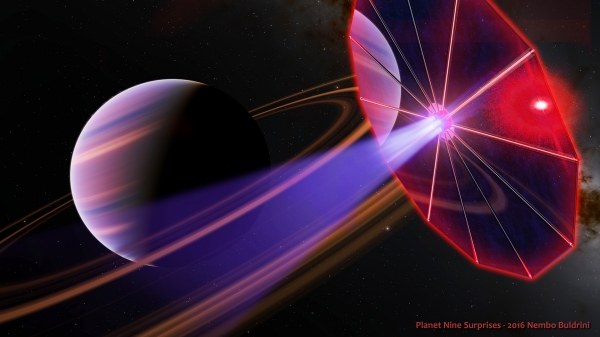
Image: An imaginative look at laser electric propulsion for a near-term mission, in this case a journey to the hypothesized Planet 9. Credit: Angelo Genovese/Nembo Buldrini.
Do notice that by ‘interstellar’ we are referring to a mission to the nearby interstellar medium rather than a mission to another star. Stepping stones are important.
Genovese and Maraqten also note John Brophy’s work at NASA’s Innovative Advanced Concepts office that delves into what Brophy considers “A Breakthrough Propulsion Architecture for Interstellar Precursor Missions.” Here Brophy works with a 2-kilometer diameter laser array beaming power across the Solar System to a 110 meter diameter photovoltaic array to feed an ion propulsion system with an ISP of 40,000 seconds. That gets a payload to 550 AU in a scant 13 years, an interesting distance as this is where gravitational lensing gets exploitable. Can we go faster and farther?
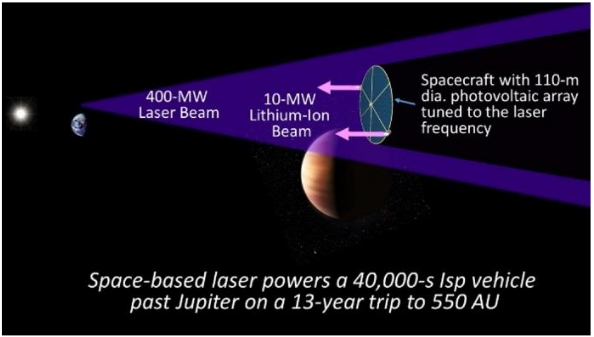
Image: John Brophy’s work at NIAC examines laser electric propulsion as a means of moving far beyond the heliosphere, all the way out to where the Sun’s gravitational lens begins to produce useful scientific results. Credit: John Brophy.
An advanced mission to 1000 AU emerged in a study Genovese performed for the Initiative for Interstellar Studies back in 2014. Here the author had considered nuclear methods for powering the craft, with reactor specific mass of 5 kg/kWe. Genovese’s calculations showed that such a craft could reach this distance in 35 years, moving at 150 km/s. This saddles us, of course, with the nuclear reactor needed for power aboard the spacecraft. In the current paper, he and co-author Maraqten ramp up the concept:
The TAU mission could greatly profit from the LEP concept. Instead of a huge nuclear reactor with a mass of 12.5 tons (1-MWe class with a specific mass of 12.5 kg/kWe), we could have a large monochromatic PV collector with 50% efficiency and a specific mass of just 1 kg/kWe… This allows us to use a more advanced ion propulsion system based on 50,000s ion thrusters. The much higher specific impulse allows a substantial reduction in propellant mass from 40 tons to 10 tons, leading to a TAU initial mass of just 23 tons instead of 62 tons. The final burnout speed is 240 km/s (50 AU/yr), 1000 AU are reached in just 25 years (Genovese, 2016 [26]).
In fact, the authors rank electric propulsion possibilities this way:
- Present EP performance involves ISP in the range of 7000 s, which can deliver a fairly near-term 200 AU mission with a cruise time in the range of 25 years.
- Advanced EP concepts with ISP of 28,000 s draw on an onboard nuclear reactor, and produce a mission to 1000 AU with a trip time of 35 years. The authors consider this ‘mid-term development.’
- In terms of long-term possibilities, very advanced EP concepts with ISP of 40,000 s can be powered by a 400 MW space laser array, giving us a 1000 AU mission with a trip time of 25 years.
So here we have a way to cluster technologies in the service of an interstellar precursor mission that operates well within the lifetime of the scientists and engineers who are working on the project. I mention this latter fact because it always comes up in discussions, although I don’t really see why. Many of the team currently working on Breakthrough Starshot, for example, would not see the launch of the first probes toward a target like Proxima Centauri even if the most optimistic scenarios for the project were realized. We don’t do these things for our ourselves. We do them for the future.
The Maraqten & Genovese paper is “Advanced Electric Propulsion Concepts for Fast Missions to the Outer Solar System and Beyond,” 73rd International Astronautical Congress (IAC), Paris, France, 18-22 September 2022 (available here). The laser rocket paper is Jackson and Whitmire, “Laser Powered Interstellar Rocket,” Journal of the British Interplanetary Society, Vol. 31 (1978), pp.335-337. The Bloomer paper is “The Alpha Centauri Probe,” in Proceedings of the 17th International Astronautical Congress (Propulsion and Re-entry), Gordon and Breach. Philadelphia (1967), pp. 225-232.

by Paul Gilster | Oct 14, 2022 | Advanced Rocketry |
How helpful can electric propulsion become as we plan missions into the local interstellar medium? We can think about this in terms of the Voyager probes, which remain our only operational craft beyond the heliosphere. Voyager 1 moved beyond the heliopause in 2012, which means 35 years between launch and heliosphere exit. But as Nadim Maraqten (Universität Stuttgart) noted in a presentation at the recent International Astronautical Congress, reaching truly unperturbed interstellar space involves getting to 200 AU. We’d like to move faster than Voyager, but how?
Working with Angelo Genovese (Initiative for Interstellar Studies), Maraqten offers up a useful analysis of electric propulsion, calling it one of the most promising existing propulsion technologies, along with various sail concepts. In fact, the two modes have been coupled in some recent studies, about which more as we proceed. The authors believe that the specific impulse of an EP spacecraft must exceed 5000 seconds to make interstellar precursor missions viable in a timeframe of 25-30 years, acknowledging that this ramps up the power needed to reach the desired delta-v.
Electric propulsion is a method of ionizing a propellant and subsequently accelerating it via electric or magnetic fields or a combination of the two. The promise of these technologies is great, for we can achieve higher exhaust velocities by far with electric methods than through any form of conventional chemical propulsion. We’ve seen that promise fulfilled in missions like DAWN, which in 2015 became the first spacecraft to orbit two destinations beyond Earth, having reached Ceres after previously exploring Vesta. We can use electric methods to reduce propellant mass or achieve, over time, higher velocities. [Addendum: Thanks to several readers who noticed that I had reversed the order of Vesta and Ceres in the DAWN mission above. I’ve fixed the mistake.]
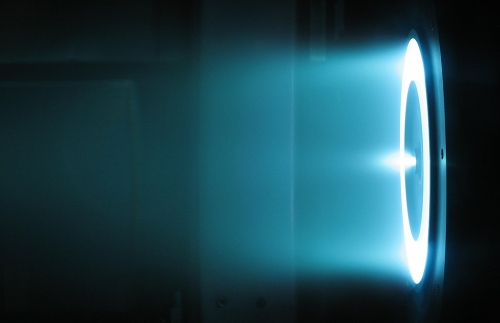
Image: 6 kW Hall thruster in operation at the NASA Jet Propulsion Laboratory
Unlike chemical propulsion, electric concepts have a relatively recent history, having appeared in Robert Goddard’s famous notebooks as early as 1906. In fact, Goddard’s 1917 patent shows us the first example of an electrostatic ion accelerator useful for propulsion, even if he worked at a time when our understanding of ions was incomplete, so that he considered the problem as one of moving electrons instead. Konstantin Tsiolkovsky had also conceived the idea and wrote about it in 1911, this from the man who produced the Tsiolkovsky rocket equation in 1903 (although Robert Goddard would independently derive it in 1912, and so would Hermann Oberth about a decade later).
As Maraqten and Genovese point out, Hermann Oberth wound up devoting an entire chapter (and indeed, the final one) of his 1929 book Wege zur Raumschiffahrt (Ways to Spaceflight) to what he describes as an ‘electric spaceship.’ That caught the attention of Wernher von Braun, and via him Ernst Stuhlinger, who conceived of using these methods rather than chemical propulsion to make von Braun’s idea of an expedition to Mars a reality. It had been von Braun’s idea to use chemical propulsion with a nitric acid/hydrazine propellant, as depicted in a famous series on space exploration that ran in Collier’s from 1952-1954.
But Stuhlinger thought he could bring the mass of the spacecraft down by two-thirds while expelling ions and electrons to achieve far higher exhaust velocity. It was he who introduced the idea of nuclear-electric propulsion, by replacing a power system based on solar energy with a nuclear reactor, thus moving us from SEP (Solar Electric Propulsion) to NEP (Nuclear Electric Propulsion). Let me quote Maraqten and Genovese on this:
Stuhlinger immersed himself in electric propulsion theory, and in 1954 he presented a paper at the 5th International Astronautical Congress in Vienna entitled, “Possibilities of Electrical Space Ship Propulsion”, where he conceived the first Mars expedition using solar-electric propulsion [4]. The spacecraft design he proposed, which he nicknamed the “Sun Ship”, had a cluster of 2000 ion thrusters using caesium or rubidium as propellant. He calculated that the total mass of the “Sun Ship” would be just 280 tons instead of the 820 tons necessary for a chemical-propulsion spaceship for the same Mars mission. In 1955 he published: “Electrical Propulsion System for Space Ships with Nuclear Source” in the Journal of Astronautics, where he replaced the solar-electric power system with a nuclear reactor (Nuclear Electric Propulsion – NEP). In 1964 Stuhlinger published the first systematic analysis of electric propulsion systems: “Ion Propulsion for Space Flight” [3], while the physics of electric propulsion thrusters was first described comprehensively in a book by Robert Jahn in 1968 [5].
In 1957, the Walt Disney television program ‘Mars and Beyond’ (shown in the series ‘Tomorrowland’) featured the fleet of ten nuclear-electric powered spacecraft that Stuhlinger envisioned for the journey. As you can see in the image below, this is an unusual design, a vehicle that became known as an ‘umbrella ship.’ I’ve quoted him before on this, but let me run the passage again. It’s from Stuhlinger’s 1955 paper “Electrical Propulsion System for Space Ships with Nuclear Power Source”:
A propulsion system for space ships is described which produces thrust by expelling ions and electrons instead of combustion gases. Equations are derived from the optimum mass ratio, power, and driving voltage of a ship with given payload, travel time, and initial acceleration. A nuclear reactor provides the primary power for a turbo-electric generator; the electric power then accelerates the ions. Cesium is the best propellant available because of its high atomic mass and its low ionization energy. A space ship with 150 tons payload and an initial acceleration of 0.67 x 10-4 G, traveling to Mars and back in a total travel time of about 2 years, would have a takeoff mass of 730 tons.
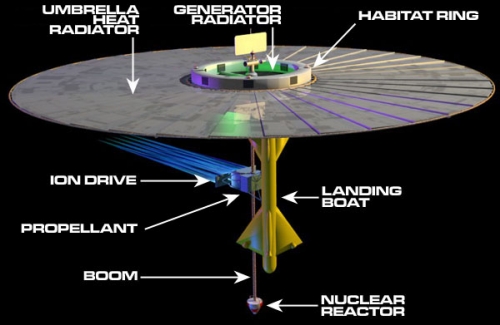
Image: Ernst Stuhlinger’s Umbrella Ship, built around ion propulsion. Notice the size of the radiator, which disperses heat from the reactor at the end of the boom. The source for this concept was a Stuhlinger paper called “Electrical Propulsion System for Space Ships with Nuclear Power Source,” which ran in the Journal of the Astronautical Sciences 2, no. Pt. 1 in 1955, pp. 149-152. Credit: Winchell Chung.
While I’ve only talked about Stuhlinger’s work on electric propulsion here, his contribution to space sciences was extensive, ranging from a staging system crucial to Explorer 1 (this involved his pushing a button at the precise time required, hence his nickname as ‘the man with the golden finger’), to his work as director of the Marshall Space Flight Center Science Laboratory, which involved an active role in plans for lunar exploration.
For his contributions to electric propulsion, the Electric Rocket Propulsion Society renamed its award for outstanding achievement as the Stuhlinger Medal after his death. In terms of his visibility to the public, those interested in space advocacy will know about his letter to Sister Mary Jucunda, a nun based in Zambia, which laid out to a profound skeptic the rationale for pursuing missions to far destinations at a time of global crisis.
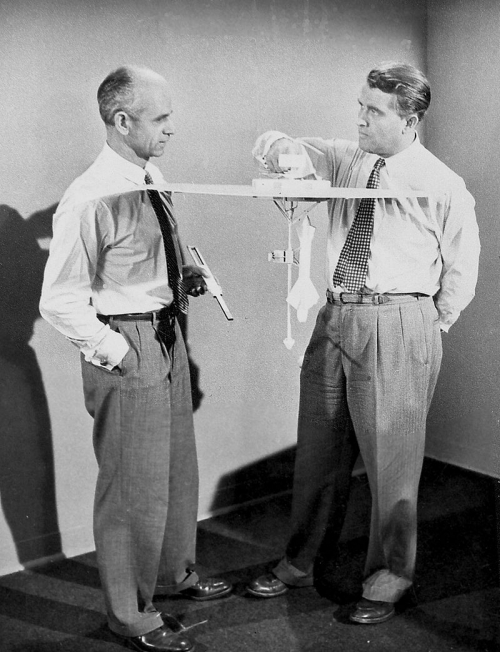
Image: In the above photo, taken at the Walt Disney Studios in California, Wernher von Braun (right) and Ernst Stuhlinger are shown discussing the technology behind nuclear-electric spaceships designed to undertake the mission to the planet Mars. As a part of the Disney ‘Tomorrowland’ series on the exploration of space, the nuclear-electric vehicles were shown in the program “Mars and Beyond,” which first aired in December 1957. Credit: NASA MSFC.
In the next post, I want to look at the deep space applications that Maraqten and Genovese considered in their IAC presentation.
For more details on Stuhlinger’s Mars ship, see Adam Crowl’s Stuhlinger Mars Ship Paper, and the followup I wrote in these pages back in 2015, Ernst Stuhlinger: Ion Propulsion to Mars. The Maraqten & Genovese paper is “Advanced Electric Propulsion Concepts for Fast Missions to the Outer Solar System and Beyond,” 73rd International Astronautical Congress (IAC), Paris, France, 18-22 September 2022 (available here). Ernst Stuhlinger’s paper on nuclear-electric propulsion is “Electrical Propulsion System for Space Ships with Nuclear Source,” appearing in the Journal of Astronautics Vol. 2, June 1955, p. 149, and available in manuscript form here. For more background on electric propulsion, see Choueiri, E., Y., “A Critical History of Electric Propulsion: The First 50 Years (1906-1956),” Journal of Propulsion and Power, vol. 20, pp. 193-203, 2004.

by Paul Gilster | Jul 26, 2022 | Advanced Rocketry |
Adam Crowl has been appearing on Centauri Dreams for almost as long as the site has been in existence, a welcome addition given his polymathic interests and ability to cut to the heart of any issue. His long-term interest in interstellar propulsion has recently been piqued by the Jet Propulsion Laboratory’s work on a mission to the Sun’s gravitational lens region. JPL is homing in on multiple sailcraft with close solar passes to expedite the cruise time, leading Adam to run through the options to illustrate the issues involved in so dramatic a mission. Today he looks at the pros and cons of nuclear propulsion, asking whether it could be used to shorten the trip dramatically. Beamed sail and laser-powered ion drive possibilities are slated for future posts. With each of these, if we want to get out past 550 AU as quickly as possible, the devil is in the details. To keep up with Adam’s work, keep an eye on Crowlspace.
by Adam Crowl
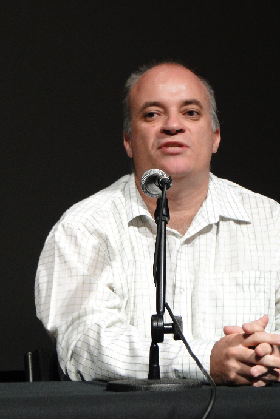
The Solar Gravitational Lens amplifies signals from distant stars and galaxies immensely, thanks to the slight distortion of space-time caused by the Sun’s mass-energy. Basically the Sun becomes an immense spherical lens, amplifying incoming light by focussing it hundreds of Astronomical Units (AU) away. Depending on the light frequency, the Sun’s surrounding plasma in its Corona can cause interference, so the minimum distance varies. For optical frequencies it can be ~600 AU at a minimum and light is usefully focussed out to ~1,000 AU.
One AU is traveled in 1 Julian Year (365.25 days) at a speed of 4.74 km/s. Thus to travel 100 AU in 1 year needs a speed of 474 km/s, which is much faster than the 16.65 km/s that probes have been launched away from the Earth. If a Solar Sail propulsion system could be deployed close to the Sun and have a Lifting Factor (the ratio of Light-Pressure to Weight of Solar Sail vehicle) greater than 1, then such a mission could be launched easily. However, at present, we don’t have super-reflective gossamer light materials that could usefully lift a payload against solar gravity.
Carbon nanotube mesh has been studied in such a context, as has aerographite, but both are yet to be created in large enough areas to carry large payloads. The ratio of the push of sunlight, for a perfect reflector, to the gravity of the Sun means an areal mass density of 1.53 grams per square metre gives a Lifting Factor of 1. A Sail with such an LF will hover when pointing face on at the Sun. If a Solar Sail LF is less than 1, then it can be angled and used to speed up or slow down the Sail relative to its initial orbital vector, but the available trajectories are then slow spirals – not fast enough to reach the Gravity Lens in a useful time.
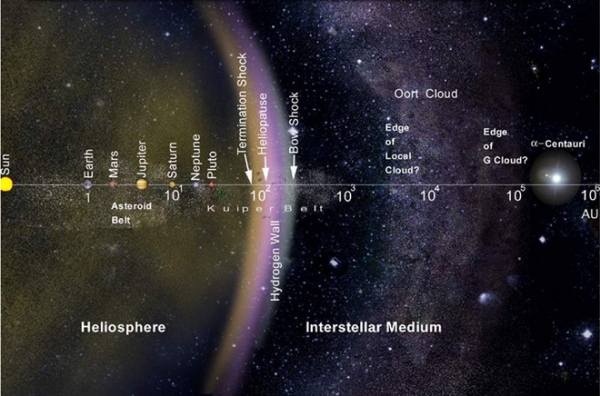
Image: A logarithmic look at where we’d like to go. Credit: NASA.
Absent super-light Solar Sails, what are the options? Modern day rockets can’t reach 474 km/s without some radical improvements. Multi-grid Ion Drives can achieve exhaust velocities of the right scale, but no power source yet available can supply the energy required. The reason why leads into the next couple of options so it’s worth exploring. For deep space missions the only working option for high-power is a nuclear fission reactor, since we’re yet to build a working nuclear fusion reactor.
When a rocket’s thrust is limited by the power supply’s mass, then there’s a minimum power & minimum travel time trajectory with a specific acceleration/deceleration profile – it accelerates 1/3 the time, then cruises at constant speed 1/3 the time, then brakes 1/3 the time. The minimum Specific Power (Power per kilogram) is:
P/M = (27/4)*S2*T-3
…where P/M is Power/Mass, S is displacement (distance traveled) and T is the total mission time to travel the displacement S. In units of AU and Years, the P/M becomes:
P/M = 4.8*S2*T-3 W/kg
However while the Average Speed is 474 km/s for a 6 year mission to 600 AU, the acceleration/deceleration must be accounted for. The Cruise Speed is thus 3/2 times higher, so the total Delta-Vee is 3 times the Average Speed. The optimal mass-ratio for the rocket is about 4.41, so the required Effective Exhaust Velocity is a bit over twice the Average Speed – in this case 958 km/s. As a result the energy efficiency is 0.323, meaning the required Specific Power for a rocket is:
P/M = 14.9*S2*T-3 W/kg
For a mission to 600 AU in 6 years a Specific Power of 24,850 W/kg is needed. But this is the ideal Jet-Power – the kinetic energy that actually goes into the forward thrust of the vehicle. Assuming the power source is 40% (40% drive and 10% payload) of the vehicle’s empty mass and the efficiency of the higher-powered multi-grid ion-drive is 80%, then the power source must produce 77,600 W/kg of power. Every power source produces waste heat. For a fission power supply, the waste heat can only be expelled by a radiator. Thermodynamic efficiency is defined as the difference in temperature between the heat-source (reactor) and the heat-sink (radiator), divided by the temperature of the heat source:
Thermal Efficiency = (Tsource – Tsink) / Tsource
For a reactor with a radiator in space, the mass of that radiator is (usually) minimised when the efficiency is 25 % – so to maximise the Power/Mass ratio the reactor has to be really HOT. The heat of the reactor is carried away into a heat exchanger and then travels through the radiator to dump the waste heat to space. To minimise mass and moving parts so called Heat-Pipes can be used, which are conductive channels of certain alloys.
Another option, which may prove highly effective given clever reactor designs, is to use high performance thermophotovoltaic (TPV) cells to convert high temperature thermal emissions directly into electrical power. High performance TPV’s have hit 40% efficiency at over 2,000 degrees C, which would also maximise the P/M ratio of the whole power system.
Pure Uranium-235, if perfectly fissioned (a Burn-Up Fraction of 1), releases 88 trillion joules (88 TJ) per kilogram. A jet-power of 24,850 W/kg sustained for 4 years is a total power output of 3.1 TJ/kg. Operating the Solar Lens Telescope payload won’t require such power levels, so we’ll assume it’s negligible fraction of the total output – a much lower power setting. So our fuel needs to be *at least* 3.6% Uranium-235. But there’s multipliers which increase the fraction required – not all the vehicle will be U-235.
First, the power-supply mass fraction and the ion-drive efficiency – a multiplier of 1/0.32. Therefore the fuel must be 11.1% U-235.
Second, there’s the thermodynamic efficiency. To minimise the radiator area (thus mass) required, it’s set at 25%. Therefore the U-235 is 45.6% of the power system mass. The Specific Power needed for the whole system is thus 310,625 W per kilogram.
The final limitation I haven’t mentioned until now – the thermophysical properties of Uranium itself. Typically Uranium is in the form of Uranium Dioxide, which is 88% uranium by mass. When heated every material goes up in temperature by absorbing (or producing internally) a certain amount of heat – the so called Heat Capacity. The total amount of heat stored in a given amount of material is called the Enthalpy, but what matters to extracting heat from a mass of fissioning Uranium is the difference in Enthalpy between a Higher and a Lower temperature.
Considering the whole of the reactor core and the radiator as a single unit, the Lower temperature will be the radiator temperature. The Higher will be the Core where it physically contacts the heat exchanger/radiator. Thanks to the Thermal efficiency relation we know that if the radiator is at 2,000 K, then the Core must be at least ~2,670 K. The Enthalpy difference is 339 kilojoules per kilogram of Uranium Oxide core. Extracting that heat difference every second maintains the temperature difference between the Source and the Sink to make Work (useful power) and that means a bare minimum of 91.6% of the specific mass of the whole power system must be very hot fissioning Uranium Dioxide core. Even if the Core is at melting point – about 3120 K – then the Enthalpy difference is 348 KJ/kg – 89.3% of the Power System is Core.
The trend is obvious. The power supply ends up being almost all fissioning Uranium, which is obviously absurd.
To conclude: A fission powered mission to 600 AU will take longer than 6 years. As the Power required is proportional to the inverse cube of the mission time, the total energy required is proportional to the inverse square of the mission time. So a mission time of 12 years means the fraction of U-235 burn-up comes down to a more achievable 22.9% of the power supply’s total mass. A reactor core is more than just fissioning metal oxide. Small reactors have been designed with fuel fractions of 10%, but this is without radiators. A 5% core mass puts the system in range of a 24 year mission time, but that’s approaching near term Solar Sail performance.

by Paul Gilster | Feb 17, 2022 | Advanced Rocketry |
Do the laser thermal concepts we discussed earlier this week have an interstellar future? To find out, applications closer to home will have to be tested and deployed as the technology evolves. Today we look at the work of Andrew Higgins and team at McGill University (Montreal), whose concept of a Mars mission using these methods is much in the news. Dr. Higgins is a professor of Mechanical Engineering at the university, where he teaches courses in the discipline of thermofluids. He has 30 years of experience in shock wave experimentation and modeling, with applications to advanced aerospace propulsion and fusion energy. His background includes a PhD (’96) and MS (’93) in Aeronautics and Astronautics from the University of Washington, Seattle, and a BS (’91) in Aeronautical and Astronautical Engineering from the University of Illinois in Urbana/Champaign. Today’s article is the first of two.
by Andrew Higgins

Directed energy propulsion continues to be the most plausible, near-term method by which we might send a probe to the closest stars, with the laser-driven lightsail being the Plan A for most interstellar enthusiasts. Before we use an enormous laser to send a probe to the stars, exploring the applications of directed energy propulsion within the solar system is of interest as an intermediate step.
Ironically, the pandemic that descended on the world in the spring of 2020 provided my research group at McGill University the stimulus to do just this. As we were locked out of our lab for the summer due to covid restrictions, our group decided to turn our attention to the mission design applications of the phased-array laser technology being developed by Philip Lubin’s group at UC Santa Barbara and elsewhere that has formed the basis of the Breakthrough Starshot initiative. If a 10-km-diameter laser array could push a 1-m lightsail to 30% the speed of light, what could we do in our solar system with a smaller, 10-m-diameter laser array based on Earth?
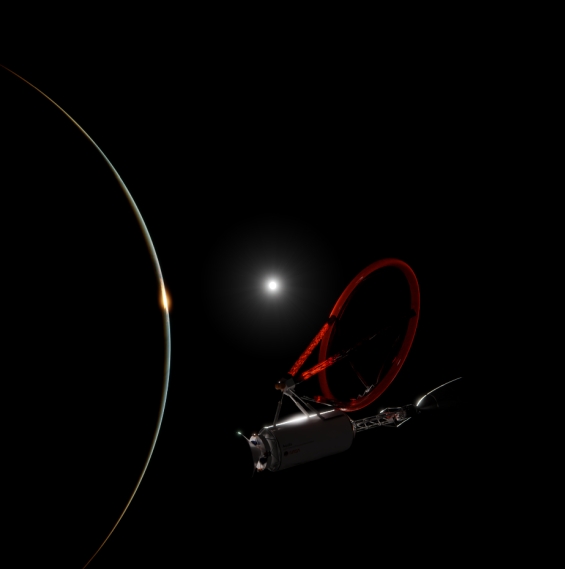
Image: Laser-thermal propulsion vehicle capable of delivering payload to the surface of Mars in 45 days.
For lower velocity missions within the solar system, coupling the laser to the spacecraft via a reaction mass (i.e., propellant) is a more efficient way to use the delivered power than reflecting it off a lightsail. Reflecting light only transfers a tiny bit of the photon’s energy to the spacecraft, but absorbing the photon’s energy and putting it into a reaction mass results in greater energy transfer.
This approach works well, at least until the spacecraft velocity greatly exceeds the exhaust velocity of the propellant; whenever using propellant, we are still under the tyranny of the rocket equation. Using laser-power to accelerate reaction mass carried onboard the spacecraft cannot get us to the stars, but for getting around the solar system, it will work just fine.
One approach to using an Earth-based laser is to employ a photovoltaic array onboard the spacecraft to convert the delivered laser power into electricity and then use it to power electric propulsion. Essentially, the idea here is to use a solar panel to power electric propulsion such as an ion engine (similar to the Deep Space 1 and Dawn spacecraft), but with the solar panel tuned to the laser wavelength for greater efficiency. This approach has been explored under a NIAC study by John Brophy at JPL [1] and by a collaboration between Lubin’s group at UCSB and Todd Sheerin and Elaine Petro at MIT [2]. The results of their studies look promising: Electric propulsion for spaceflight has always been power-constrained, so using directed energy could enable electric propulsion to achieve its full potential and realize high delta-V missions.
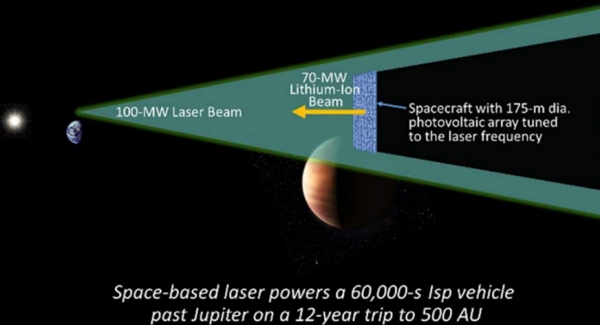
Image: Laser-electric propulsion, explored as part of a NIAC study by JPL in 2017. Image source: https://www.nasa.gov/directorates/spacetech/niac/2017_Phase_I_Phase_II/Propulsion_Architecture_for_Interstellar_Precursor_Missions/
There are some limits to laser-electric propulsion, however. Photovoltaics are temperature sensitive and are thus limited by how much laser flux you can put onto them. The Sheerin et al. study of laser-electric propulsion used a conservative limit for the flux on the photovoltaics to the equivalent of 10 “suns”. This flux, combined with the better efficiency of photovoltaics that could be optimized to the wavelength of the laser, would increase the power generated by more than an order of magnitude in comparison to solar-electric propulsion, but a phase-array laser has the potential to deliver much greater power. Also, since electric propulsion has to run for weeks in order to build up a significant velocity change, the laser array would need to be large—in order to maintain focus on the ever receding spacecraft—and likely several sites would need to be built around the world or perhaps even situated in space to provide continuous power.
I had spent my sabbatical with Philip Lubin’s group in Santa Barbara in 2018 and was fortunate to be an enthusiastic fly-on-the-wall as the laser-electric propulsion concept was being developed but—being an old-time gasdynamicist—there was not much I could contribute. There is another approach to laser-powered propulsion, however, that I thought was worth a look and suited to my group’s skill set: laser-thermal propulsion. Essentially, the laser is used to heat propellant that is expanded out of a traditional nozzle, i.e., a giant steam kettle in space. The laser flux only interacts with a mirror on board the spacecraft to focus the laser through a window and into the propellant heating chamber, and these components can withstand much greater fluxes, in principle, up to the equivalent of tens of thousands of suns. The greater power that can be delivered results in greater thrust, so a more intense propulsive maneuver can be performed nearer to Earth. The closer to Earth the propulsive burn is, the smaller the laser array needs to be in order to keep the beam focused on the spacecraft, making it more feasible as a near-term demonstration of directed energy propulsion. The challenge is that the laser fluxes are intense and do not lend themselves to benchtop testing; could we come up with a design that could feasibly handle the extreme flux?
Our effort was led by Emmanuel Duplay, our “Chief Designer,” who happens to be a gifted graphic artist and whose work graces the final design. We also had Zhuo Fan Bao on our team, who had just finished his undergraduate honors thesis at McGill on modelling the laser-induced ionization and absorption by the hydrogen propellant—the physics that was at the heart of the laser-thermal propulsion concept [3]. Heading into the lab to measure the predictions of Zhuo Fan’s thesis research was our plan for the summer of 2020, but when the pandemic dropped, we pivoted to the mission design aspects of the concept instead. Together with the rest of our team of undergraduate students—all working remotely via Zoom, Slack, Notion, and all the other tools that we learned to adopt through the summer of 2020—we dove into the detailed design.

Image: McGill Interstellar Flight Experimental Research Group meeting-up in person for the first time on Mont Royal in Montreal, during the early days of the pandemic, summer 2020.
Our design team benefitted greatly from prior work on both laser-thermal propulsion and gas-core nuclear thermal rockets done in the 1970s. Laser-thermal propulsion is well-trodden ground, going back to the seminal study by Arthur Kantrowitz [4], who is my academic great grandfather of sorts. In the 1970s, the plan was to use gasdynamic lasers—imagine using an F-1 rocket engine to pump a gas laser—operating at the 10-micron wavelength of carbon dioxide. With the biggest optical elements people could conceive of at the time—a lens about a meter in diameter—combined with this longer wavelength, laser propulsion would be limited to Earth-to-space launch or low Earth orbit. To the first order, the range a laser can reach is given by the diameter of the lens times the diameter of the receiver, all divided by the wavelength of laser light. So, targeting a 10-m diameter receiver, you can only beam a CO2 laser about a thousand kilometers. The megawatt class lasers that were conceived at the time were not really up to the job of powering Earth-to-orbit launchers, which typically require gigawatts of power. For many years, Jordin Kare kept the laser-thermal space-launch concept alive by exploring how small a laser-driven launch vehicle could be made. By the 1980s, most studies focused on using laser-thermal rockets for orbit transfer from LEO, an application that requires lower power[5].
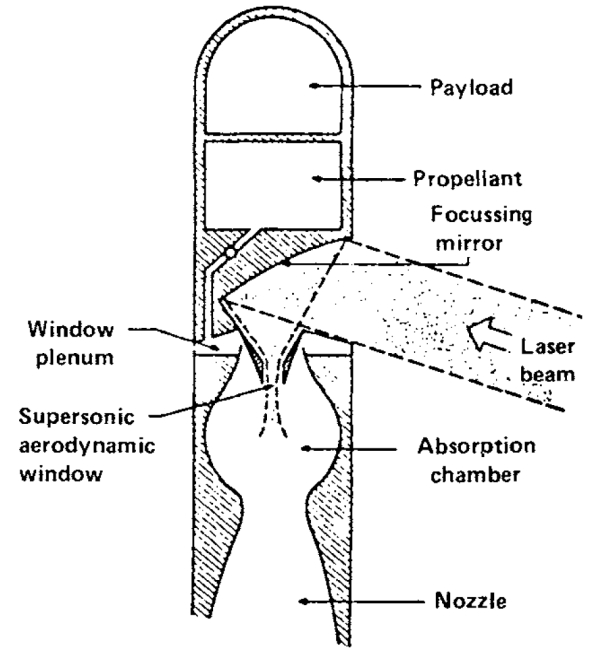
Image: Concept for a laser-thermal rocket from the early 1980s, using a 10-micron-wavelength CO2 laser. Image Source: Kemp, Physical Sciences Incorporated (1982).
As a personal footnote, I was fixated with laser-thermal propulsion in the 1980s as an undergraduate aerospace engineering student studying Kantrowitz and Kare’s work and, in 1991, visited all of the universities that had worked on laser propulsion, hoping I could do research in this field as a graduate student. I was told by the experts—politely but firmly—that the concept was dying or at least on pause; with the end of the Cold War, who was going to fund the development of the multi-megawatt lasers needed?
The recent emergence of inexpensive, fiber-optic lasers that could be combined in a phased array changed this picture and—thirty years later—I could finally come back to the concept that had been kicking around the back of my mind. The fact that fiber optic lasers operate at 1 micron (rather than 10 microns) and could be assembled as an array 10-m in effective optical diameter means they could reach a hundred times further into space than previously considered. Greater power, shorter wavelength, and bigger optical diameter might multiply together as a win-win-win combination and open up the possibility to rapid transit in the solar system.
The other prior literature we greatly benefitted from is gas-core nuclear thermal rockets. Unlike classic, solid-core NERVA rockets that are limited by the materials that make up the heating chamber, gas core nuclear thermal rockets contain the fissile material as plasma in the center of the heating chamber that does not come into contact with the walls. Work on this concept progressed in the 1960s and early 1970s, and studies concluded that containing temperatures of 50,000 K should be feasible. The literature on this topic is extensive, but Winchell Chung’s Atomic Rockets website provides a good introduction [6]. Work from the early 1970s concluded specific impulses exceeding 3000 s were achievable, but leakage of fissile material and its products from the gas core were both a performance limiting issue and an environmental nonstarter for use near Earth. But what if we could create the same conditions in the gas core using a laser, without loss of uranium or radioactive waste to worry about? The heat transfer and wall cooling issues between gas core NTR and the laser-thermal rocket neatly overlap, so we could adopt many of the strategies previously developed to contain these temperatures while keeping the walls of our heating chamber cool.
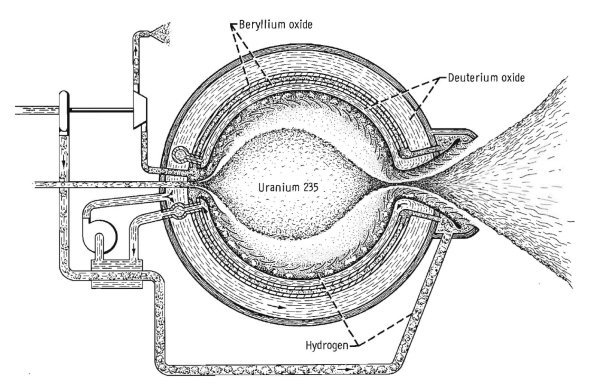
Image: Gas-core nuclear thermal rocket. Image source: Rom, Nuclear-Rocket Propulsion, (NASA, 1968).
Laser-thermal propulsion is sometimes called the poor person’s nuclear thermal rocket. Given its lack of radioactive materials and associated issues, I would argue that laser-thermal propulsion is rather the enlightened person’s nuclear rocket.
With this stage set, in the next installment, we will take a closer look at the final results of our Mars-in-45-day mission design study.
References
1. John Brophy et al., A Breakthrough Propulsion Architecture for Interstellar Precursor Missions, NIAC Final Report (2018)
https://ntrs.nasa.gov/api/citations/20180006589/downloads/20180006589.pdf
2. Sheerin, Todd F., Elaine Petro, Kelley Winters, Paulo Lozano, and Philip Lubin. “Fast Solar System transportation with electric propulsion powered by directed energy.” Acta Astronautica (2021).
https://doi.org/10.1016/j.actaastro.2020.09.016
3. Bao, Zhuo Fan and Andrew J. Higgins. “Two-Dimensional Simulation of Laser Thermal Propulsion Heating Chamber” AIAA Propulsion and Energy 2020 Forum (2020).
https://doi.org/10.2514/6.2020-3518
4. Arthur Kantrowitz, “Propulsion to Orbit by Ground-Based Lasers,” Astronautics and Aeronautics (1972).
5. Leonard H. Caveny, editor, Orbit-Raising and Maneuvering Propulsion: Research Status and Needs (AIAA, 1984).
https://doi.org/10.2514/4.865633
6. http://www.projectrho.com/public_html/rocket/enginelist2.php#gcnroc

by Paul Gilster | Jul 9, 2021 | Advanced Rocketry, Uncategorized |
Building a Bussard ramjet isn’t easy, but the idea has a life of its own and continues to be discussed in the technical literature, in addition to its long history in science fiction. Peter Schattschneider, who explored the concept in Crafting the Bussard Ramjet last February, has just published an SF novel of his own called The EXODUS Incident (Springer, 2021), where the Bussard concept plays a key role. But given the huge technical problems of such a craft, can one ever be engineered? In this second part of his analysis, Dr. Schattschneider digs into the question of hydrogen harvesting and the magnetic fields the ramjet would demand. The little known work of John Ford Fishback offers a unique approach, one that the author has recently explored with Centauri Dreams regular A. A. Jackson in a paper for Acta Astronautica. The essay below explains Fishback’s ideas and the options they offer in the analysis of this extraordinary propulsion concept. The author is professor emeritus in solid state physics at Technische Universität Wien, but he has also worked for a private engineering company as well as the French CNRS, and has been director of the Vienna University Service Center for Electron Microscopy.
by Peter Schattschneider

As I mentioned in a recent contribution to Centauri Dreams, the BLC1 signal that flooded the press in January motivated me to check the science of a novel that I was finishing at the time – an interstellar expedition to Proxima Centauri on board a Bussard ramjet. Robert W. Bussard’s ingenious interstellar ramjet concept [1], published in 1960, inspired a generation of science fiction authors; the most celebrated is probably Poul Anderson with the novel Tau Zero [2]. The plot is supposedly based on an article by Carl Sagan [3] who references an early publication of Eugen Sänger where it is stated that due to time dilation and constant acceleration at 1 g „[…] the human lifespan would be sufficient to circumnavigate an entire static universe“ [4].
Bussard suggested using magnetic fields to scoop interstellar hydrogen as a fuel for a fusion reactor, but he did not discuss a particular field configuration. He left the supposedly simple problem to others as Newton did with the 3-body problem, or Fermat with his celebrated theorem. Humankind had to wait 225 years for an analytic solution of Newton‘s problem, and 350 years for Fermat’s. It took only 9 years for John Ford Fishback to propose a physically sound solution for the magnetic ramjet [5].
The paper is elusive and demanding. This might explain why adepts of interstellar flight are still discussing ramjets with who-knows-how-working superconducting coils that generate magnetic scoop fields reaching hundreds or thousands of kilometres out into space. Alas, it is much more technically complicated.
Fishback’s solution is amazingly simple. He starts from the well known fact that charged particles spiral along magnetic field lines. So, the task is to design a field the lines of which come together at the entrance of the fusion reactor. A magnetic dipole field as on Earth where all field lines focus on the poles would do the job. Indeed, the fast protons from the solar wind are guided towards the poles along the field lines, creating auroras. But they are trapped, bouncing between north and south, never reaching the magnetic poles. The reason is rather technical: Dipole fields change too rapidly along the path of a proton in order to keep it on track.
Fishback simply assumed a sufficiently slow field variation along the flight direction, Bz=B0/(1+ ? z) with a „very small“ ?. Everything else derives from there, in particular the parabolic shape of the magnetic field lines. Interestingly, throughout the text one looks in vain for field strengths, let alone a blueprint of the apparatus. The only hint to the visual appearance of the device is a drawing of a long, narrow paraboloid that would suck the protons into the fusion chamber. As a shortcut to what the author called the region dominated by the ramjet field I use here the term „Fishback solenoid“.
Fig. 1 is adapted from the original [5]. I added the coils that would create the appropriate field. Their distance along the axis indicates the decreasing current as the funnel widens. Protons come in from the right. Particles outside the scooping area As are rejected by the field. The mechanical support of the coils is indicated in blue. It constitutes a considerable portion of the ship’s mass, as we shall see below.

Fig. 1: Fishback solenoid with parabolic field lines. The current carrying coils are symbolized in red. The mechanical support is in blue. The strong fields exert hoop stress on the support that contributes considerably to the ship’s mass. Adapted from [5].
Searching for scientific publications that build upon Fishback’s proposal, Scopus renders 6 citations up to this date (April 2021). Some of them deal with the mechanical stress of the magnetic field, another aspect of Fishback’s paper that I discuss in the following, but as far as I could see the paraboloidal field was not studied in the 50 years since. This is surprising because normally authors continue research when they have a promising idea, and others jump on the subject, from which follow-up publications arise, but J. F. Fishback published only this one paper in his lifetime. [On Fishback and his tragic destiny, see John Ford Fishback and the Leonora Christine, by A. A. Jackson].
Solving the dynamic equation for protons in the Fishback field proves that the concept works. The particles are guided along the parabolic field lines toward the reactor as shown in the numerical simulation Fig. 2.

Fig.2: Proton paths in an (r,z)-diagram. r is the radial distance from the symmetry axis, z is the distance along this axis. The ship flies at 0.56 c (?=0.56) in positive z-direction. In the ship’s rest frame, protons arrive with a kinetic energy of 194 MeV from the top. Left: Protons entering the field at z=200 km are focussed to the reactor mouth at the coordinate origin, gyrating over the field lines. Particles following the red paths make it to the chamber; protons following the black lines spiral back. The thick grey parabola separates the two regimes. Right: Zoom into the first 100 m in front of the reactor mouth of radius 10 m. Magnetic field lines are drawn in blue.
The reactor intake is centered at (r,z)=(0,0). In the ship’s rest frame the protons arrive from top – here with 56 % of light speed, the maximum speed of the EXODUS in my novel [8]. Some example trajectories are drawn. Protons spiral down the magnetic field lines as is known from earth’s magnetic field and enter the fusion chamber (red lines). The scooping is well visible. The reactor mouth has an assumed radius of 10 m. A closer look into the first 100 m (right figure) reveals an interesting detail: Only the first two trajectories enter the reactor. Protons travelling beyond the bold grey line are reflected before they reach the entrance, just as charged particles are bouncing back in the earth’s field before they reach the poles. From the Figure it is evident that at an axial length of 200 km of the Fishback solenoid the scoop radius is disappointingly low – only 2 km. Nevertheless, the compression factor (focussing ions from this radius to 10 m) of 1:40.000 is quite remarkable.
The adiabatic condition mentioned above allows a simple expression for the area from which protons can be collected. The outer rim of this area is indicated by the thick grey line in Fig. 2. The supraconducting coils of the solenoid should ideally be built following this paraboloid, as sketched in Fig. 1. Tuning the ring current density to

yields a result that approximates Fishback‘s field closely.
What does it mean in technical terms? Let me discuss an idealized example, having in mind Poul Anderson’s novel. The starship Leonora Christina accelerates at 1 g, imposing artificial earth gravity on the crew. Let us assume that the ship‘s mass is a moderate 1100 tons (slightly less than 3 International Space Stations). For 1 g acceleration on board, we need a peak thrust of ~11 million Newton, about 1/3 of the first stage of the Saturn V rocket. The ship must be launched with fuel on stock because the ramjet operates only beyond a given speed, often taken as 42 km/s, the escape velocity from the solar system. In the beginning, the thrust is low. It increases with the ship’s speed because the proton throughput increases, asymptotically approaching the peak thrust.
Assuming complete conversion of fusion energy into thrust, total ionisation of hydrogen atoms, and neglecting drag from deviation of protons in the magnetic field, at an interstellar density of 106 protons/m3, the „fuel“ collected over one square kilometer yields a peak thrust of 1,05 Newton, a good number for order-of-magnitude estimates. That makes a scooping area of ~10 million square km, which corresponds to an entrance radius of about 1800 km of the Fishback solenoid. From Fig. 2, it is straightforward to extrapolate the bold grey parabola to the necessary length of the funnel – one ends up with fantastic 160 million km, more than the distance earth – sun. (At this point it is perhaps worth mentioning that this contribution is a physicist’s treatise and not that of an engineer.)
Plugging the scooping area into the relativistic rocket equation tells us which peak acceleration is possible. The results are summarised in Table 1. For convenience, speed is given in units of the light speed, ß=v/c. Additionally, the specific momentum ß? is given where

is the famous relativistic factor. (Note: The linear momentum of 1 kg of matter would be ß? c.) Acceleration is in units of the earth gravity acceleration, g=9.81 m/s2.
Under continuous acceleration such a starship would pass Proxima Centauri after 2.3 years, arrive at the galactic center after 11 years, and at the Andromeda galaxy after less than 16 years. Obviously, this is not earth time but the time elapsed for the crew who profit from time dilation. There is one problem: the absurdly long Fishback solenoid. Even going down to a scooping radius of 18 km, the supraconducting coils would reach out 16,000 km into flight direction. In this case the flight to our neighbour star would last almost 300 years.
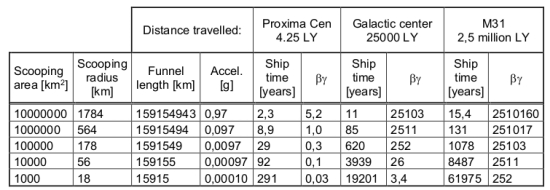
Table 1: Acceleration and travel time to Proxima Centauri, the galactic center, and the Andromeda galaxy M31, as a function of scooping area. ß? is the specific momentum at the given ship time. A ship mass of 1100 tons, reactor entrance radius 10 m, and constant acceleration from the start was assumed. During the starting phase the thrust is low, which increases the flight time by one to several years depending on the acceleration.
Fishback pointed out another problem of Bussard ramjets [5]. The magnetic field exerts strong outward Lorentz forces on the supraconducting coils. They must be balanced by some rigid support, otherwise the coils would break apart. When the ship gains speed, the magnetic field must be increased in order to keep the protons on track. Consequently, for any given mechanical support there is a cut-off speed beyond which the coils would break. For the Leonora Christina a coil support made of a high-strength „patented“ steel must have a mass of 1100 tons in order to sustain the magnetic forces that occur at ?=0,74.
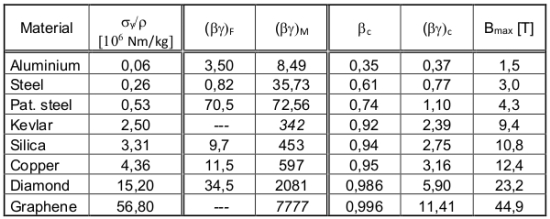
Table 2: Cut-off speeds ?c and cut-off specific momenta (ß?)c (upper bounds) for several support materials. (ß?)F from [5], (ß?)M from [7]. ?y/? is the ratio of the mechanical yield stress to the mass density of the support material. Bmax is the maximum magnetic field at the reactor entrance at cut-off speed. A scooping area of 10 million km2 was assumed, allowing a maximum acceleration of ~1 g for a ship of 1100 tons. Values in italics for Kevlar and graphene, unknown in the 1960s, were calculated based on equations given in [7].
But we assumed above that this is the ship‘s entire mass. That said, the acceleration must drop long before speeding at 0,74 c. The cut-off speed ?c=0,74 is an upper bound (for mathematicians: not necessarily the supremum) for the speed at which 1 g acceleration can be maintained. Lighter materials for the coil support would save mass. Fishback [5] calculated upper bounds for the speed at which an acceleration of 1 g is still possible for several materials such as aluminium or diamond (at that time the strongest lightweight material known). Values are shown in Table 2 together with (ß?)c.
Martin [7] found some numerical errors in [5]. Apart from that, Fishback used an optimistically biased (ß?)c. Closer scrutiny, in particular the use of a more realistic rocket equation [6], results in more realistic upper bounds. Using graphene, the strongest material known, the specific cut-off momentum is 11,41. This value would be achieved after a flight of three years at a distance of 10 light years. After that point, the acceleration would rapidly drop to values making it hopeless to reach the galatic center in a lifetime.
In conclusion, the interstellar magnetic ramjet has severe construction problems. Some future civilization may have the knowhow to construct fantastically long Fishback solenoids and to overcome the minimum mass condition. We should send a query to the guys who flashed the BLC1 signal from Proxima Centauri. The response is expected in 8.5 years at the earliest. In the meantime the educated reader may consult a tongue-in-cheek solution that can be found in my recent scientific novel [8].
Acknowledgements
Many thanks to Al Jackson for useful comments and for pointing out the source from which Poul Anderson got the idea for Tau Zero, and to Paul Gilster for referring me to the seminal paper of John Ford Fishback.
References
[1] Robert W. Bussard: Galactic Matter and Interstellar Flight. Astronautica Acta 6 (1960), 1-14.
[2] Poul Anderson: Tau Zero. Doubleday 1970.
[3] Carl Sagan: Direct contact among galactic civilizations by relativistic inter-stellar space flight, Planetary and Space Science 11 (1963) 485-498.
[4] Eugen Sänger: Zur Mechanik der Photonen-Strahlantriebe. Oldenbourg 1956.
[5] John F. Fishback: Relativistic Interstellar Space Flight. Astronautica Acta 15 (1969), 25-35.
[6] Claude Semay, Bernard Silvestre-Brac: The equation of motion of an interstellar Bussard ramjet. European Journal of Physics 26 (1) (2005) 75-83.
[7] Anthony R. Martin: Structural limitations on interstellar space flight. Astronautica Acta 16 (6) (1971) 353-357.
[8] Peter Schattschneider: The EXODUS Incident. Springer 2021,
ISBN: 978-3-030-70018-8. https://www.springer.com/de/book/9783030700188#aboutBook


























